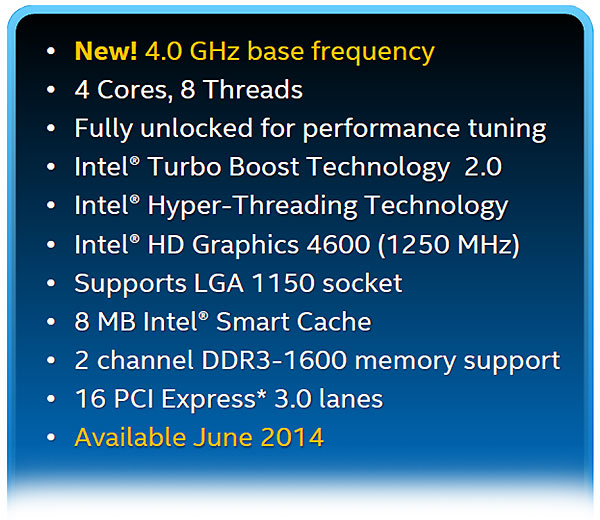Devil's Canyon: Intel Core i7-4790K OC'ing and Review
Introduction and Specifications
Intel has been slowly releasing information about its Devil’s Canyon processors for a few months now. If you’ve been on top of the processor scene, you probably know that Devil’s Canyon is the codename for a new revision of Intel’s 4th Gen Core processors, based on the Haswell microarchitecture, that features a high performance polymer thermal interface material (TIM) and updated packaging materials, in addition to an array of additional capacitors to smooth power delivery to the core.
Devil’s Canyon’s updates are designed to resolve some thermal and overclocking related issues that were first introduced into Intel’s processor line-up with Ivy Bridge. If you recall, Intel started using a lower-performing thermal interface material between Ivy Bridge chips and their integrated heat spreaders that resulted in higher temperatures under load versus Sandy Bridge. Further compounding the issue, Intel moved Haswell's voltage regulator on-die, which created an additional hot spot on the processor itself. When overclocking, increased frequencies and higher voltages pushed temperatures up significantly with the Fully Integrated Voltage Regulator, or FIVR as it’s known.
The Devil’s Canyon details Intel had strategically released up until a few days ago was all high-level information and lacked specifics about particular model numbers, pricing, and performance. On June 3, however, Intel made all of the juicy details public and a soon thereafter we got our hands on the company’s current flagship Devil’s Canyon based processor, the Core i7-4790K. And today, we can finally give you the full scoop...
Belly Of The Beast: The Underside Of A Core i7-4790K
|

Find The Intel Core i7-4790K @ Amazon.com
The Core i7-4790K’s main features and specifications are listed in the chart above. The processor features four cores, but thanks to Intel’s Hyper Threading technology, it can process eight threads. It also has a base clock of 4.0GHz—the highest base-clock of any Intel processor to date—support for Intel’s Turbo Boost technology, which can crank clock up to 4.4GHz on all cores simultaneously, 8MB of cache memory, and 16 integrated PCIe 3.0 lanes. The Core i7-4790K is also outfitted with Intel’s HD 4600 series graphics engine (clocked at 1250MHz), and like all other “K-SKUs”, the processor is fully unlocked for easy overclocking. Save for its frequencies (and the updates made to Devil’s Canyon mentioned in the intro), the Core i7-4790K is similar to previous Haswell-based processors, like the Core i7-4770K.
Core i7-4770K (left), Core i7-4790K "Devil's Canyon" (right)
As we’ve already mentioned, Devil’s Canyon processors like the Core i7-4790K feature additional capacitors to help smooth power delivery to the die. Smoother, more consistent, and reliable power delivery to the processor should help stability under load, while overclocking, and could potentially help push its ultimate top-end frequency somewhat higher. The additional capacitors are visible in the picture above; that’s the underside of a Core i7-4770K on the left, the Core i7-4790K is on the right.
The processors are the same size, are also compatible with the same cooling solutions, and they work in the same LGA 1150 socket as well. With Devil’s Canyon, however, you may need a newer Intel 9 series chipset-based motherboard, like the recently released Z97X, though some motherboard manufacturers are planning to support the processors on high-end 8-series chipset motherboards as well.






